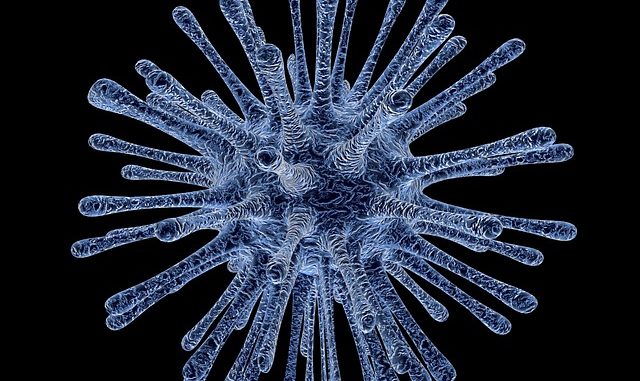
A virus is a non-cellular particle which consists of genetic material and protein that enables it to invade living cells. Some do contain lipid as well but not all. They can only reproduce in living cells (animals, plants and bacteria).
A virus is not considered a living thing and so is not ‘dead’ either. It is often described as an obligatory parasite. To be living requires the organism to have at least a cellular structure with a cell membrane encapsulating cytoplasm. Living organisms can do cell division independently which is either sexual or asexual. They can show growth as well as differentiation. Living cells also obtain and use energy which a virus cannot do.
Whilst a virus needs a living host for its reproduction, the host range is diverse and usually highly specific. As we detail later, the diversity of host cells infected is a consequence of virus structure and function. Another key feature is that viruses contain genes which allows them to mutate and to evolve. It is not clear how they developed but they may well have evolved from bacteria that have lost key pieces of machinery and from plasmids which are pieces of DNA that move between cells.
Viruses that invade bacteria are also called bacteriophages.
There are over 5,000 species of virus known.
The First Ideas About Immunity And The Role Of Viruses
The idea of a virus starts with Edward Jenner, who in 1798 first introduced the term where it is the Greek word for ‘poison’. Edward Jenner, the great Gloucestershire doctor observed that milk maids could be infected with cowpox but did not ever develop smallpox. Smallpox is a deadly infection whereas cowpox causes severe discomfort but does not kill. He tested the idea that people with cowpox were developing immunity to smallpox. He inoculated a boy with some vesicle fluid taken from the hand of a maid infected with cowpox. The boy was found to have developed sustained immunity against smallpox.
Jenner reasoned that the vesicle fluid contained a poison (hence the word ‘virus’) that was responsible for immunity.
The Characteristics Of Viruses
Viruses are much smaller than bacteria. They generally have a size of between 20 and 300 nanometers (nm) whereas a bacteria is measured on the micrometer scale.
They contain either one type of nucleic acid, which is DNA or RNA but never both.
Generally, their structure is a nucleic acid surrounded by a protein coat which is called a capsid. A number of viruses have an additional lipoprotein envelope which serves as protection. They are not cells so they lack any organelles including mitochondria or ribosomes.
Most microbiologists and virologists consider them to be obligate parasites because they can only replicate in living cells. They replicate themselves by injecting their nucleic acid into a cell which is replicated and then produces the viral protein.
Viruses cannot be cultured in isolation on chemically defined media, they must be cultured in living cells. Likewise, they do not undergo any form of binary fission because they have no cellular apparatus for mitosis or meiosis.
The capsid which is the protein coat of the virus is made up of smaller structural units called capsomeres. The capsid’s function is to protect the nucleic acid from being inactivated by both chemical physical damage.
The lipoprotein envelope is an additional covering but not all viruses have them. This envelope is mainly composed of the virally coded protein with the host’s lipid. This viral envelop is covered with glycoprotein spikes which serve as recognition points.
A few viruses have key enzymes contained inside them with the DNA. The single-strand RNA viruses (ssRNA virus) which show what is termed negative polarity contain an enzyme called a reverse transcriptase that resides inside the virion. The transcriptase is an RNA dependent RNA polymerase. Two viruses which cause disease that contain this transcriptase include retroviruses and hepatitis B.
The Symmetry Of A Virus Particle
Viruses have a remarkable symmetry of structure. They can be classified in three groups which is based on the morphology of the nucleocapsid and the arrangement of the capsomeres.
A virus with cubic symmetry is icosahedral or almost spherical in shape with the nucleic acid contained inside the capsid. This type of particle is made up of 20 equilateral triangles, 12 vertices and posses 2,3,5 rotational symmetry.
A virus with helical symmetry is usually elongated or pleomorphic which means it is not spherical. The nucleic acid is contained in the capsid in a spiral shape with the capsomeres arranged spherically around it.
There are virus particles with much more complex symmetry because of their complicated structure.
The Baltimore Classification
Viruses are now divided into six groups based on their nucleic acid and mRNA production. (mRNA – messenger ribonucleic acid). They are:-
(1) double strand DNA viruses (ds-DNA)
(2) single-strand DNA viruses (ss-DNA)
(3) double strand RNA viruses (ds-RNA)
(4) single-strand RNA viruses (ss-RNA). These have a positive strand which also means they have positive polarity.
(5) single-strand RNA viruses (ss-RNA). These have a negative strand which also means they have negative polarity.
(6) single-strand RNA viruses (ss-RNA) which also contain the enzyme, reverse transcriptase.
Spread And Vectors
Virus infection is often termed as a spread. There are many ways in which they can be spread and then infect host species or tissues. Animal cell viruses are spread by exposure to infected bodily fluids whilst plant viruses will spread from plant to plant using insects and other organisms.
Viral Diseases
Smallpox and cowpox, autoimmune deficiency syndrome (AIDS) caused by the HIV virus, the common cold, influenza(flu), coronaviral flu, warts.
Virus Infection: The Process Of Infection
The Binding Of Viruses To Cell Membranes And How They Get In!
Viruses need to enter a living cell to replicate. To do so means they must cross the cell’s membrane which acts as a barrier and this is an important prerequisite to infection. To get across the membrane, they must attach themselves to the surface of the target cell.
There are a few sequential binding steps that are common to all viruses when they infect bacteria, plants and animal cells. There are some general membrane components which allow for initial binding of the virus. At this stage the binding interaction is non-specific and weak.
The components recognized on the cell are mainly sialic acid and HSPG (heparan sulphate proteoglycan) in animal cells. In plant cells, these are teichoic acids and lipopolysaccharides (LPS).
A stronger binding phase follows which involves a wide range of virus-specific receptors that are exposed at the surface. Such binding stabilizes what was an initially weak attachment by the virus.
The attachment prepares the virus for entry into the cell and is one of the most important elements of infection. Binding of the virus to a virus-specific receptor produces some complex and strong interactions. These produce structural and conformational changes in the virus leading to the production of an activated viral intermediate. This intermediate triggers a mechanism for entry into the cell.
Take these two virus examples:-
The HIV (human immunodeficiency virus) interacts with the protein CD4 (cluster of differentiation 4) which is a glycoprotein on the surface of immune cells such as the T-cells. It achieves this through its viral envelope protein called gp120. The binding to CD4 causes a shift in the conformation of gp120. This allows the virus to bind to the co-receptor expressed on the host cell membrane. The coreceptors are chemokine receptors called CCR5 or CXCR4. Binding than causes a structural change in another viral protein called gp41. The virus inserts a fusion peptide into the host cell allowing the outer membrane of the virus to then fuse with the host cell’s membrane.
The T-bacteriophages need a lipopolysaccharide and an Omp protein such as OmpA and OmpC which is the ‘outer membrane protein’ on the host’s cell membrane for binding.
Taking HIV as a good example, it uses membrane fusion to release its contents into the cytoplasm of the target host’s cell. The virus is able to insert its genetic material into the host DNA using the following process. The viral capsid is released into the cytoplasm where upon the capsid coat is released.
A complex virus directed mechanism then takes place. It involves various cellular proteins such as CPSF6, CyPA and TNPO3. HIV, under the Baltimore classification has a reverse transcriptase which converts the viral RNA into DNA. Whilst the capsid is disassembling it offers protection to the fragile RNA so that it is not degraded.
The newly-formed DNA (nascent DNA) and the viral integrase are transported along microtubules. helped by various cellular cofactors. The microtubules transport the DNA and enzyme through the nuclear pore to the nucleus for the ‘pre-integration complex’ to insert the viral DNA into the host DNA.
Good References
Caspar, D.L.D. (1975). Design principles in virus particle construction. In: Horsfall FL, Tamm I (eds) Viral and Rickettsial Infections in Man. 4th Ed. J.B. Lippincott, Philadelphia.
Leiman, P. G., Kanamaru, S., Mesyanzhinov, V. V., Arisaka, F., & Rossmann, M. G. (2003). Structure and morphogenesis of bacteriophage T4. Cellular and Molecular Life Sciences CMLS, 60(11), pp. 2356-2370.
Nermut, M.V., Stevens, A.C. (eds) (1989) Animal Virus Structure. Elsevier, Amsterdam.


Leave a Reply